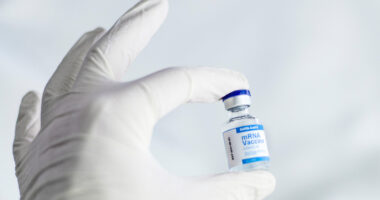Skin sarcoidosis treated with organ transplant medicine sirolimus: Trial
Treatment reduced or eliminated skin granulomas; benefits persisted over a year

An immunosuppressive medication that’s used to prevent organ rejection after transplantation successfully treated cutaneous sarcoidosis, a type of sarcoidosis of the skin, in most patients in a small clinical trial.
Sirolimus, which suppresses a signaling pathway called mTOR, reduced or eliminated skin granulomas and its benefits persisted for more than a year after four months of daily oral treatment. Granulomas are the clumps of pro-inflammatory immune cells that characterize and drive sarcoidosis.
Data from the pilot trial were published in The Lancet Rheumatology in “Efficacy and safety of mTOR inhibition in cutaneous sarcoidosis: a single-center trial.”
“We suspect that, unlike broad-spectrum immunosuppressants, mTOR inhibition targets both immune and non-immune cells in granulomas, which prevents a recurrence of tissue granulomas,” said Georg Stary, MD, in a university press release. Stary was the study’s senior author and is a professor at the department of dermatology at Medical University of Vienna.
The researchers plan to conduct a larger, multicenter trial to confirm sirolimus’s benefits in cutaneous sarcoidosis and further test its efficacy in the lungs, which are often affected by sarcoidosis.
“Given the rarity of sarcoidosis and the fact that mTOR inhibitors such as sirolimus are no longer patented, research interest from the industry is limited,” said Stary, who is also an adjunct principal investigator at CeMM Research Center for Molecular Medicine of the Austrian Academy of Sciences in Vienna.
The promising results of this pilot trial highlight “the importance of investigator-initiated studies and academic research,” Stary said.
Treating sarcoidosis of the skin
In cutaneous sarcoidosis, granulomas form in the skin. Symptoms include a rash of reddish-purple bumps, usually on the ankles or shins, which may be tender to the touch, and/or skin lesions on the cheeks, nose, and ears.
Treatments include creams containing corticosteroids, an anti-inflammatory and immunosuppressive medication. Corticosteroid oral tablets, such as prednisone, are used for more severe cases, but long-term treatment is associated with serious side effects. Other immunosuppressant therapies may be prescribed if the condition doesn’t respond to corticosteroids.
Sirolimus, also known as rapamycin and sold as Rapamune, among others, is used to prevent organ rejection after a transplant. It targets mTOR signaling, which is involved in inflammatory immune responses and granuloma formation in sarcoidosis.
Because no clinical trial has been published to investigate the effectiveness and safety of sirolimus in sarcoidosis patients, and there’s no evidence that supports using it topically as a cream in skin sarcoidosis, the researchers conducted a small, single-center trial (EudraCT 2017-004930-27) to test sirolimus in 16 adults (10 women, six men) with persistent, active, cutaneous sarcoidosis who didn’t respond to corticosteroids. The study was funded by the Vienna Science and Technology Fund.
Participants were randomly assigned either 0.1% topical sirolimus in vaseline, or vaseline alone as a placebo, twice daily for four months. After a one-month washout period without treatment, all the participants received a 6 mg loading dose of oral sirolimus solution followed by a 2 mg daily dose for another four months.
The trial’s main goal was a change in cutaneous sarcoidosis disease activity after either topical or oral systemic (body-wide) treatment, as assessed using the Cutaneous Sarcoidosis Activity and Morphology Index (CSAMI). Higher scores indicate worse skin symptoms, and a drop of at least 5 points was considered a relevant clinical improvement.
After four months of topical treatment, there was no significant difference in CSAMI scores between sirolimus and the placebo groups.
Effectiveness of oral treatment
Among the 12 patients who began oral sirolimus, 10 (83%) completed the four-month treatment period.
In contrast to topical treatment, four months of systemic sirolimus significantly decreased CSAMI scores, demonstrating skin symptom improvement. Seven patients (70%) showed a CSAMI score drop of at least 5 points (responders), with skin lesions completely clearing in three of them. Treatment response occurred across different types of lesions.
Responders saw their skin granulomas decrease in size, with four showing no granulomas after treatment and three having a substantial size reduction. No change in granuloma size was seen in three participants.
Also, decreased mTOR activity was detected in skin cells from responding participants, “suggesting that sirolimus might act directly on tissue granulomas.”
Improvements persisted after treatment was withdrawn during the short-term follow-up (two months) and the long-term follow-up of up to two years, with no reported sarcoidosis relapses. While quality of life assessments indicated an improvement in the short-term follow-up, the treatment didn’t reduce fatigue.
There were no reported side effects related to topical treatment. The most common side effects from systemic treatment were mild skin reactions (42%) and elevated levels of blood triglyceride fats (17%) and sugar (17%). No serious side effects nor deaths were reported.
“Our study provides valuable insights into the treatment response with sirolimus for different [lesions] of cutaneous sarcoidosis and their effect on tissue granuloma,” the scientists wrote. “It strongly advocates that the application of mTOR inhibitors in granulomatous inflammation should be examined in larger [appropriately controlled] clinical trials.”







